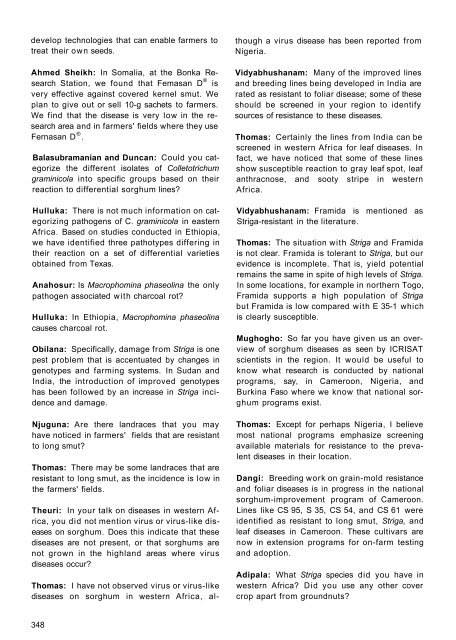Sorghum Diseases in India
Sorghum Diseases in India
Sorghum Diseases in India
You also want an ePaper? Increase the reach of your titles
YUMPU automatically turns print PDFs into web optimized ePapers that Google loves.
develop technologies that can enable farmers to<br />
treat their own seeds.<br />
Ahmed Sheikh: In Somalia, at the Bonka Research<br />
Station, we found that Femasan D ® is<br />
very effective aga<strong>in</strong>st covered kernel smut. We<br />
plan to give out or sell 10-g sachets to farmers.<br />
We f<strong>in</strong>d that the disease is very low <strong>in</strong> the research<br />
area and <strong>in</strong> farmers' fields where they use<br />
Fernasan D ® .<br />
Balasubramanian and Duncan: Could you categorize<br />
the different isolates of Colletotrichum<br />
gram<strong>in</strong>icola <strong>in</strong>to specific groups based on their<br />
reaction to differential sorghum l<strong>in</strong>es?<br />
Hulluka: There is not much <strong>in</strong>formation on categoriz<strong>in</strong>g<br />
pathogens of C. gram<strong>in</strong>icola <strong>in</strong> eastern<br />
Africa. Based on studies conducted <strong>in</strong> Ethiopia,<br />
we have identified three pathotypes differ<strong>in</strong>g <strong>in</strong><br />
their reaction on a set of differential varieties<br />
obta<strong>in</strong>ed from Texas.<br />
Anahosur: Is Macrophom<strong>in</strong>a phaseol<strong>in</strong>a the only<br />
pathogen associated with charcoal rot?<br />
Hulluka: In Ethiopia, Macrophom<strong>in</strong>a phaseol<strong>in</strong>a<br />
causes charcoal rot.<br />
Obilana: Specifically, damage from Striga is one<br />
pest problem that is accentuated by changes <strong>in</strong><br />
genotypes and farm<strong>in</strong>g systems. In Sudan and<br />
<strong>India</strong>, the <strong>in</strong>troduction of improved genotypes<br />
has been followed by an <strong>in</strong>crease <strong>in</strong> Striga <strong>in</strong>cidence<br />
and damage.<br />
Njuguna: Are there landraces that you may<br />
have noticed <strong>in</strong> farmers' fields that are resistant<br />
to long smut?<br />
Thomas: There may be some landraces that are<br />
resistant to long smut, as the <strong>in</strong>cidence is low <strong>in</strong><br />
the farmers' fields.<br />
Theuri: In your talk on diseases <strong>in</strong> western Africa,<br />
you did not mention virus or virus-like diseases<br />
on sorghum. Does this <strong>in</strong>dicate that these<br />
diseases are not present, or that sorghums are<br />
not grown <strong>in</strong> the highland areas where virus<br />
diseases occur?<br />
Thomas: I have not observed virus or virus-like<br />
diseases on sorghum <strong>in</strong> western Africa, al<br />
348<br />
though a virus disease has been reported from<br />
Nigeria.<br />
Vidyabhushanam: Many of the improved l<strong>in</strong>es<br />
and breed<strong>in</strong>g l<strong>in</strong>es be<strong>in</strong>g developed <strong>in</strong> <strong>India</strong> are<br />
rated as resistant to foliar disease; some of these<br />
should be screened <strong>in</strong> your region to identify<br />
sources of resistance to these diseases.<br />
Thomas: Certa<strong>in</strong>ly the l<strong>in</strong>es from <strong>India</strong> can be<br />
screened <strong>in</strong> western Africa for leaf diseases. In<br />
fact, we have noticed that some of these l<strong>in</strong>es<br />
show susceptible reaction to gray leaf spot, leaf<br />
anthracnose, and sooty stripe <strong>in</strong> western<br />
Africa.<br />
Vidyabhushanam: Framida is mentioned as<br />
Striga-resistant <strong>in</strong> the literature.<br />
Thomas: The situation with Striga and Framida<br />
is not clear. Framida is tolerant to Striga, but our<br />
evidence is <strong>in</strong>complete. That is, yield potential<br />
rema<strong>in</strong>s the same <strong>in</strong> spite of high levels of Striga.<br />
In some locations, for example <strong>in</strong> northern Togo,<br />
Framida supports a high population of Striga<br />
but Framida is low compared with E 35-1 which<br />
is clearly susceptible.<br />
Mughogho: So far you have given us an overview<br />
of sorghum diseases as seen by ICRISAT<br />
scientists <strong>in</strong> the region. It would be useful to<br />
know what research is conducted by national<br />
programs, say, <strong>in</strong> Cameroon, Nigeria, and<br />
Burk<strong>in</strong>a Faso where we know that national sorghum<br />
programs exist.<br />
Thomas: Except for perhaps Nigeria, I believe<br />
most national programs emphasize screen<strong>in</strong>g<br />
available materials for resistance to the prevalent<br />
diseases <strong>in</strong> their location.<br />
Dangi: Breed<strong>in</strong>g work on gra<strong>in</strong>-mold resistance<br />
and foliar diseases is <strong>in</strong> progress <strong>in</strong> the national<br />
sorghum-improvement program of Cameroon.<br />
L<strong>in</strong>es like CS 95, S 35, CS 54, and CS 61 were<br />
identified as resistant to long smut, Striga, and<br />
leaf diseases <strong>in</strong> Cameroon. These cultivars are<br />
now <strong>in</strong> extension programs for on-farm test<strong>in</strong>g<br />
and adoption.<br />
Adipala: What Striga species did you have <strong>in</strong><br />
western Africa? Did you use any other cover<br />
crop apart from groundnuts?








